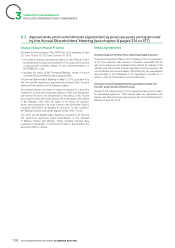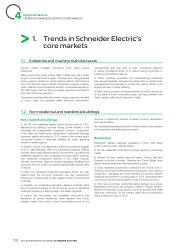APC 2015 Annual Report Download - page 175
Download and view the complete annual report
Please find page 175 of the 2015 APC annual report below. You can navigate through the pages in the report by either clicking on the pages listed below, or by using the keyword search tool below to find specific information within the annual report.
2015 REGISTRATION DOCUMENT SCHNEIDER ELECTRIC 173
CORPORATE GOVERNANCE
3
INTERNAL CONTROL AND RISK MANAGEMENT
The audit assignments go beyond the Key Internal Controls, and
include an in-depth review of processes and their effectiveness.
Internal Audit also reviews newly acquired units to assess their level
of integration into the Group, the level of internal control and the
effectiveness of operational processes, as well as ensuring Group
rules and guidelines are properly applied, and more generally
compliance with the law.
A summary overview of the department’s audits makes it possible
to identify any emerging or recurring risks that require new risk
management tools and methodologies or adjustments to existing
resources.
In2015, Internal Audit performed 30 audits, including:
•audits of units;
•audits of a number of risks or operating processes;
•post-acquisition audits for newly acquired companies;
•analyses of internal control self-assessments by the audited units;
•follow-up audits to ensure recommendations are applied;
•assisstance assignments.
Fraud Committee
The Fraud Committee defi nes the policy against fraud and the
process of reporting and treating fraud and suspected fraud,
including changes in procedures or practices to avoid recurrence.
The limited Fraud Committee is composed of the Group General
Counsel& Chief compliance offi cer, head of Global Security and
the head of Internal Audit& Internal Controls; it meets on a monthly
basis as well as on ad-hoc basis.
It deals with cases of fraud, corruption, confl ict of interest, breach of
procedure, theft and related matters. All reported cases of fraud are
reported to the Fraud Committee.
The Fraud Committee decides on investigations that are managed
either locally by the Compliance Offi cer, or centrally by a member
of the Fraud Committee depending on the seriousness of the
incident and the level of management potentially involved. The
Fraud Committee ensures the implementation of the action plan,
the appropriate sanction as well as feedback for each proven case
of fraud. A report is written and updated regularly for this purpose.
The Fraud Committee presents an annual summary report to the
Audit Committee.
9.6 Internal control procedures governing the production and processing
ofconsolidated and individual company accounting and financial information
In addition to:
•its regulatory tasks;
•its responsibility for overseeing the close of accounts across the
Group;
•its audits of the Group’s results with respect to set targets (see
«Internal Control Organization and Management: Finance and
Control– Legal Affairs Department»).
The Management Control and Accounting unit is tasked with
overseeing:
•the quality of reporting packages submitted monthly by
subsidiaries;
•the results of programmed procedures;
•the integrity of the consolidation system database.
In addition, the Management Control and Accounting unit ensures
that:
•given that the Group consolidated fi nancial statements are
fi nalized a few weeks after the annual and half-year balance
sheet date, subsidiaries perform a hard close at May31, and
November30, of each year so that most closing adjustments for
the period can be calculated in advance;
•the scope of consolidation as well as the Group’s interest and
the type of control (exclusive control, joint control, signifi cant
infl uence,etc.) in each subsidiary, from which the consolidation
method results are determined in cooperation with the Legal
Affairs Department;
• the Management Control and Accounting unit issues instructions
to the units on the closing process, including reporting deadlines,
required data and any necessary adjustments;
•the Group’s consolidated fi nancial statements are analyzed
in detail, to understand and check the main contributions by
subsidiaries, as well as the type of transactions recorded;
•accounting classifi cations are verifi ed;
•the preparation and approval of the statement of changes in
equity and the cash fl ow statement are the key control points.
The internal controls used to confi rm the existence, completeness
and value of assets and liabilities are based on:
•each subsidiary’s responsibility for implementing procedures
providing an adequate level of internal control;
•defi ning levels of responsibility for authorizing and checking
transactions;
•segregating tasks to help ensure that all transactions are justifi ed;
•the integration of statutory and management reporting systems
developed to guarantee the completeness of transaction data
recorded in the accounts;
•all of the subsidiaries apply IFRS with regard to recognition
principles, measurement and accounting methods, impairment
and verifi cation;
•the checks and analyses as described above performed by the
Management Control and Accounting unit.
























